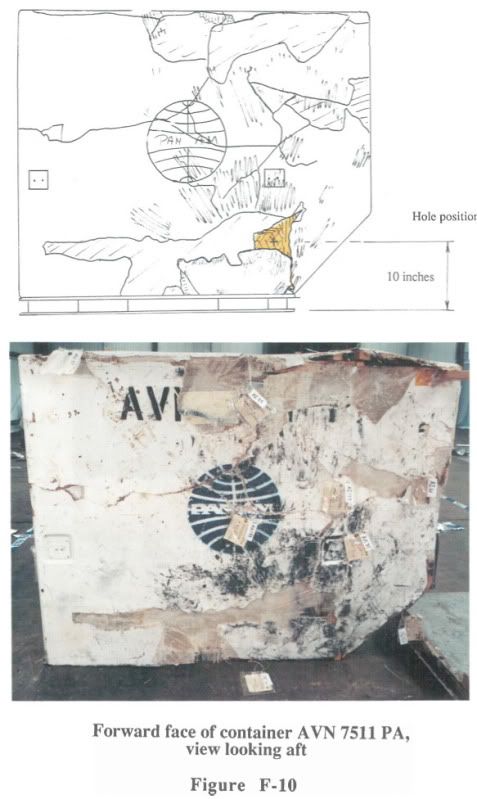June 25 2010
This site has previously covered aluminum luggage container AVE 4041 PA, which clearly had contained the explosive device that destroyed Flight 103. Of the many other container in the hold as the bomb went off, only one has any investigative importance – AVN 7511, same model but made of fiberglass, was parked next to the blast container, immediately aft, in position 21L.
Below are two illustrations from the AAIB’s report – a sketch by Mr. Claiden, and a photograph. This what would normally be called the back face of the container’s back wall, but was forward-facing when loaded. This surface was just inches from AVE 4041’s front side when the blast happened.
A container’s front (loading) side is open – apart from a small outboard side panel, it’s essentially one absent wall, with the bags secured in flight using a retractable blue tarp door that latches at the bottom. This would provide little protection to AVN 7511, but might help cause the dark spatters at lower right, directly opposite the blast zone. The marked cut-off of the mess on the right-hand side is the edge of the door/flap, where the metal side panel starts.
This whole container wall is cracked in several areas, and exactly what here is blast damage vs. damage from the fall and landing is unsure. But we know the bomb suitcase in the lower outboard corner of its container, roughly ten inches above floor level. Note a span of damage near the bottom, starting at about that height (I measured it). The outer layer of glossed fiberglass is removed, leaving the fibrous under-layer exposed. And at the right end of that, something seems to have punched a small hole clear through the container’s back wall (highlighted yellow in Claiden’s sketch).
This damage is in fact directly across from the precise blast center. Its sudden right vertical edge marks about the dead center, again cut-off by the door edge. Claiden cites this five-inch hole as the main clue establishing the level of the blast inside AVE 4041, consistent with a flat-laid case on the second level up. The reasoning seems sound enough. The hole itself by my measurement starts ten inches up, and its center is about 12.5 iches, suggesting the blast center is a tad higher than Claiden found, which I already suspected.
What punched the hole?
One explanation mentioned for this puncture is the securable metal end of AVE 4041’s retractable tarp door. This seems to ne the main explanation, and seems plausible enough, but this lone entry has some competition for what made it.
One piece of damaged luggage – a purple canvas carryall labeled PH/137 – held a clue. Actually it held two clues, pieces of magnesium suitcase frame called PT/22, found to be from the bottom (hinge) end of the primary suitcase. PH/137 was the subject of some contention at trial, being both London-origin luggage and apparently blast-damaged. It’s generally thought that all damaged luggage was in container AVE 4041 and none of that was of London origin. (This will be explained better elsewhere).
I’ve already posted some strangely evasive statements by Allen Feraday about his and Dr. Hayes’ treatment of this case. In the broader discussion I hadn’t seen then, the nagging question no one could answer clearly was whether this bag had been inside AVE 4041 or AVN 7511. No one can say for sure, but it does seem possible that those bits called PT/22 created that hole before burying themselves in that purple bag next door. Otherwise, it was in the same container, and raises some questions about what was in 4041.
A stranger culprit can be found in TSH/346, a severely distorted steel suitcase frame, found to be 2030 millimetres in length. That’s 80 inches, nearly seven feet. It was originally from a 29-inch blue, softshell American Tourister brand suitcase, apparently blasted open and flayed out. This important piece of luggage (as explained in a separate post) is thought to have been right under the bomb suitcase.
But among the items removed from this mammoth TSH/346 was PT/39(c), “a fragment of fibreglass/plastics from AVN 7511 PA.” Is it possible this whole length of frame was hurled across and smacked the top off that fiberglass? The whole broad strip of damage runs across about 55 inches, or nearly the whole door width.
Unlikely. The rough strip is neither above nor below the blast, as that American Tourister was thought to be. What should hit along that line is superheated debris from the Samsoinite holding the bomb, high-pressure explosive gasses, and a shower of melting tarp. Perhaps TSH/346 just partially impacted that lower portion in the center. And perhaps there’s a bit of theater in that fiberglass find. It wouldn’t be the first time something shady happened around that luggage.
Subscribe to:
Post Comments (Atom)



1 comment:
Nice post.Thank you for taking the time to publish this information very informative! So happy to be given a privilege to post a comment here.
aissa
www.joeydavila.net
Post a Comment